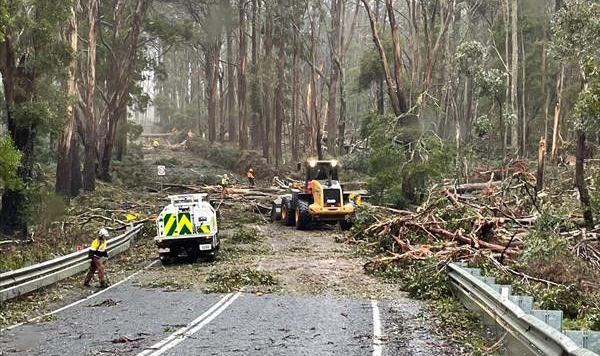
DEECA crews clear roads after the 2021 storms
Why are these works happening?
We have an obligation to ensure the safety of communities and the protection of the environment from the risks of bushfires.
A 2021 storm impacted around 45,000 hectares across Wombat State Forest - approximately 1,600 hectares was severely impacted.
It's essential to manage storm debris and hazardous trees, which can:
- increase fuel for a bushfire
- block access for community, and vital firefighting personnel and equipment.
The severely impacted areas (approximately 1,600 hectares or 4% of the impacted area) are being addressed for fire risk. We are not removing every tree that has fallen during the storms, only those that are necessary to reduce bushfire and other safety risks.
These are not commercial timber harvesting operations.
Without these works, we would not be able to keep our communities in and around the Wombat State Forest safe.
Location of works
Due to the extent of the damage, this is a multi-year program to reduce bushfire risk from the storm debris. We will continue to prioritise areas that pose the biggest fire safety risk.
View the map below for specific work areas and status of work.
The pins on the map show you:
- roadside works in purple - horizontal hatching
- broadacre works in orange - vertical hatching (broadacre means works in areas beyond roads and tracks).
If you zoom in, you will see the hatched area and the boundary of each treatment site.
Clicking on a pin or a hatched area, will provide you with information about a site, including:
- a unique site number
- the name of the location of where works are taking place, usually relating to a road or track
- which organisation they are being done for, usually DEECA and sometimes on behalf of a land manager
- a description of the status of the works, with an estimated start or finish date for the works (if available).
Please note: The hatched area on the map is the total site area. The treatment area that debris is being removed from is generally only part of the site area.
In State forests,Public Safety Zones will be put in place before works begin on any site. This restricts access to make sure everyone is safe while heavy machinery is in the area. It is an offence to enter a Public Safety Zone. For works in National Parks, Parks Victoria will manage closures.
Timeline
Works are currently underway. We expect to complete the program to reduce bushfire risk in storm-affected areas of the Wombat State Forest by June 2026, weather permitting.
Debris management
We are removing some fallen trees. These can generate significant radiant heat and block essential firefighting access during a bushfire. We don't remove every tree that has fallen during the storms, only those that are necessary to reduce bushfire and other risks. We leave some fallen trees for wildlife habitat.
We will not remove standing trees unless they pose a safety risk.
Learn more about how we manage environmental values.
Supporting the environment during storm recovery
The storm, like a bushfire, significantly damaged the forest.
As we did after the 2019–2020 fires, we support the plants and animals that live there while it recovers.
This means recovery and bushfire risk reduction works may also include:
- Biodiversity surveys to check for environmental values
- excluding sensitive areas from works
- re-planting indigenous plant species (pictured below)
- repairing tracks following operations
- minimising soil disturbance
- treating invasive weeds
- creating new tree hollows for animals in storm-affected areas
- installing rope bridges that connect animals with habitat.
What progress has been made so far?
We have graded more than 100 km of roads, cleared 1,400 km of roads and fire access tracks of hazardous debris and reopened them in both the Wombat State Forest and Cobaw State Forest.
In the Wombat State Forest, we have:
- addressed fire risk in 387 hectares out of 1638 hectares to date
- created more than 185 nesting hollows for threatened wildlife in the Wombat State Forest, and 300 on private property
- installed three rope bridges between trees to connect habitat for animals
- provided firewood for the community.
Where is the timber and debris going?
Windblown timber that is removed from the forest during storm recovery works is assessed for its highest and best end use. It could be made available as domestic firewood or to support local businesses. Find out more about available firewood on the Firewood collection in your region page.
Debris has also been given a second life as plant stakes and wood wool for animal bedding, among other things. Root balls are being used for fish habitat along streams. You can read more about these uses of storm debris in the Storm debris finds new life as animal bedding article.
Managing fire risk outside of storm recovery work
We work year-round alongside partner agencies, local government and communities to develop and deliver the Joint Fuel Management Plan. Find out more on the Joint Fuel Management Plan (JFMP) page.
Useful links
Page last updated: 04/03/25